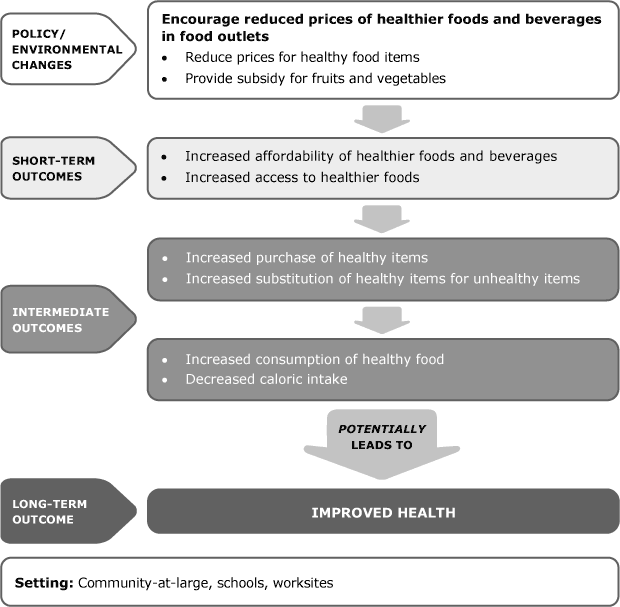Our Healthier Communities
Our Healthier Communities Initiatives are built on the concept that local communities can work together to give all community members healthy choices and support the pursuit of healthy lifestyles. More than 160 Ys are working in collaboration with community leaders to make changes in policies and the physical surroundings in those communities so that healthy living is within reach for individuals of all ages and backgrounds.
Encourage Reduced Prices of Healthy Foods and Beverages in Food Outlets
Reducing the price of healthy foods increases the sales and consumption of those healthy foods. Reducing prices through policy initiatives and subsidies can help to remove cost barriers.
Evidence suggests that price reductions on healthy food in schools and worksites are an effective strategy to increase the sales and consumption of the healthy food—as long as the cost remains reduced. Furthermore, studies found that consumption increased with steeper price discounts. Reducing prices through policy initiatives (e.g., USDA School Breakfast Program, WIC) and subsidies is a recommended approach to removing cost barriers to healthy food and increasing vegetable and fruit consumption. For example, a targeted subsidy for vegetables and fruits in the WIC program increased vegetable and fruit intake, which was sustained over time. These changes predict reduced overweight and improved health.
References
- Dong, D., & Lin, B. (2009). Fruit and vegetable consumption by low-income Americans: Would a price reduction make a difference? USDA. A Report from the Economic Research Service, 70.
- Epstein, L., Dearing, K., Paluch, R., Roemmich, J.N., & Cho, D. (2007). Price and maternal obesity influence purchasing of low- and high-energy dense foods. American Journal of Clinical Nutrition, 86(4), 914–922.
- French, S., Story, M., Jeffery, R.W., Snyder, P., Eisenberg, M., Sidebottom, A., & Murray, D. (1997). A pricing strategy to promote fruit and vegetable purchase in high school cafeterias. Journal of American Dietetic Association, 97(9), 1008–1010.
- Herman, D.R., Harrison, G.G., Abdelmonem, A, & Jenks, E. (2008). Effect of a targeted study on intake of fruits and vegetables among low-income women in the special supplemental nutrition program for women, infants, and children. Am J Public Health, 98(1), 98–105.
- Horgen, KB, & Brownell, KD. (2002). Comparison of price change and health message interventions in promoting healthy food choices. Health Psychology, 21(5), 505–512.
- Jeffery, R.W., French, S.A., Raether, C., & Baxter, J.E. (1994). An environmental intervention to increase fruit and salad purchases in a cafeteria. Preventive Medicine, 23(6), 788–792.
- Kennedy, E., & Davis, C. (1998). US Department of Agriculture School Breakfast Program. The American Journal of Clinical Nutrition, 67(suppl), 798S–803S.
- Powell, L., Zhao, Z., & Wang, Y. (2009). Food prices and fruit and vegetable consumption among young American adults. Health and Place, 15, 1064–1070.

More Healthy Living Strategies
-
Healthy Eating Strategy #1
Healthy Living Strategies -
Healthy Eating Strategy #2
Healthy Living Strategies -
Healthy Eating Strategy #3
Healthy Living Strategies